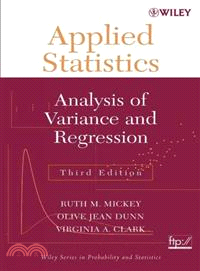Applied Statistics: Analysis Of Variance And Regression, Third Edition
商品資訊
商品簡介
". . . overall this is an excellent book . . . I recommend this book to everyone . . ."
—Statistical Methods in Medical Research
". . . it contains a wealth of useful up-to-date information and examples from the health sciences."
—Technometrics
Applied Statistics: Analysis of Variance and Regression, Third Edition has been thoroughly revised to provide a comprehensive and up-to-date combination of sound statistical methodology, practical advice on the application of this methodology, and interpretation of output from statistical programs. Special features include comprehensive treatment of each topic, from summarization of data to presentation of results; a greater emphasis on regression, data screening, and confidence intervals; in-depth discussion of design-related topics such as mixed models and random effects; and overviews of more advanced topics. This valuable, self-contained textbook is eminently suitable for upper-undergraduate/graduate students and applied researchers with an interest in ANOVA techniques.
作者簡介
OLIVE JEAN DUNN, PHD, is Professor Emeritus at the University of California, Los Angeles.
VIRGINIA A. CLARK, PHD, is also Professor Emeritus at the University of California, Los Angeles. Drs. Dunn and Clark are the authors of Basic Statistics: A Primer for Biomedical Sciences, Third Edition, published by Wiley.
目次
1. Data Screening.
1.1 Variables and Their Classification.
1.2 Describing the Data.
1.2.1 Errors in the Data.
1.2.2 Descriptive Statistics.
1.2.3 Graphical Summarization.
1.3 Departures from Assumptions.
1.3.1 The Normal Distribution.
1.3.2 The Normality Assumption.
1.3.3 Transformations.
1.3.4 Independence.
1.4 Summary.
Problems.
References.
2. One-Way Analysis of Variance Design.
2.1 One-Way Analysis of Variance with Fixed Effects.
2.1.1 Example.
2.1.2 The One-Way Analysis of Variance Model with Fixed Effects.
2.1.3 Null Hypothesis: Test for Equality of Population Means.
2.1.4 Estimation of Model Terms.
2.1.5 Breakdown of the Basic Sum of Squares.
2.1.6 Analysis of Variance Table.
2.1.7 The F Test.
2.1.8 Analysis of Variance with Unequal Sample Sizes.
2.2 One-Way Analysis of Variance with Random Effects.
2.2.1 Data Example.
2..2.2 The One-Way Analysis of Variance Model with Random Effects.
2.2.3 Null Hypothesis: Test for Zero Variance of Population Means.
2.2.4 Estimation of Model Terms.
2.2.5 The F Test.
2.3 Designing an Observational Study or Experiment.
2.3.1 Randomization for Experimental Studies.
2.3.2 Sample Size and Power.
2.4 Checking if the Data Fit the One-Way ANOVA Model.
2.4.1 Normality.
2.4.2 Equality of Population Variances.
2.4.3 Independence.
2.4.4 Robustness.
2.4.5 Missing Data.
2.5 What to Do if the Data Do Not Fit the Model.
2.5.1 Making Transformations.
2.5.2 Using Nonparametric Methods.
2.5.3 Using Alternative ANOVAs.
2.6 Presentation and Interpretation of Results.
2.7 Summary.
Problems.
References.
3. Estimation and Simultaneous Inference.
3.1 Estimation for Single Population Means.
3.1.1 Parameter Estimation.
3.1.2 Confidence Intervals.
3.2 Estimation for Linear Combinations of Population Means.
3.2.1 Differences of Two Population Means.
3.2.2 General Contrasts for Two or More Means.
3.2.3 General Contrasts for Trends.
3.3 Simultaneous Statistical Inference.
3.1.1 Straightforward Approach to Inference.
3.3.2 Motivation for Multiple Comparison Procedures and Terminology.
3.3.3 The Bonferroni Multiple Comparison Method.
3.3.4 The Tukey Multiple Comparison Method.
3.3.5 The Scheffé Multiple Comparison Method.
3.4 Inference for Variance Components.
3.5 Presentation and Interpretation of Results.
3.6 Summary.
Problems.
References.
4. Hierarchical or Nested Design.
4.1 Example.
4.2 The Model.
4.3 Analysis of Variance Table and F Tests.
4.3.1 Analysis of Variance Table.
4.3.2 F Tests.
4.3.3 Pooling.
4.4 Estimation of Parameters.
4.4.1 Comparison with the One-Way ANOVA Model of Chapter 2.
4.5 Inferences with Unequal Sample Sizes.
4.5.1 Hypothesis Testing.
4.5.2 Estimation.
4.6 Checking If the Data Fit the Model.
4.7 What to Do If the Data Don't Fit the Model.
4.8 Designing a Study.
4.8.1 Relative Efficiency.
4.9 Summary.
Problems.
References.
5. Two Crossed Factors: Fixed Effects and Equal Sample Sizes.
5.1 Example.
5.2 The Model.
5.3 Interpretation of Models and Interaction.
5.4 Analysis of Variance and F Tests.
5.5 Estimates of Parameters and Confidence Intervals.
5.6 Designing a Study.
5.7 Presentation and Interpretation of Results.
5.8 Summary.
Problems.
References.
6 Randomized Complete Block Design.
6.1 Example.
6.2 The Randomized Complete Block Design.
6.3 The Model.
6.4 Analysis of Variance Table and F Tests.
6.5 Estimation of Parameters and Confidence Intervals.
6.6 Checking If the Data Fit the Model.
6.7 What to Do if the Data Don't Fit the Model.
6.7.1 Friedman's Rank Sum Test.
6.7.2 Missing Data.
6.8 Designing a Randomized Complete Block Study.
6.8.1 Experimental Studies.
6.8.2 Observational Studies.
6.9 Model Extensions.
6.10 Summary.
Problems.
References.
7. Two Crossed Factors: Fixed Effects and Unequal Sample Sizes.
7.1 Example.
7.2 The Model.
7.3 Analysis of Variance and F Tests.
7.4 Estimation of Parameters and Confidence Intervals.
7.4.1 Means and Adjusted Means.
7.4.2 Standard Errors and Confidence Intervals.
7.5 Checking If the Data Fit the Two-Way Model.
7.6 What To Do If the Data Don't Fit the Model.
7.7 Summary.
Problems.
References.
8. Crossed Factors: Mixed Models.
8.1 Example.
8.2 The Mixed Model.
8.3 Estimation of Fixed Effects.
8.4 Analysis of Variance.
8.5 Estimation of Variance Components.
8.6 Hypothesis Testing.
8.7 Confidence Intervals for Means and Variance Components.
8.7.1 Confidence Intervals for Population Means.
8.7.2 Confidence Intervals for Variance Components.
8.8 Comments on Available Software.
8.9 Extensions of the Mixed Model.
8.9.1 Unequal Sample Sizes.
8.9.2 Fixed, Random, or Mixed Effects.
8.9.3 Crossed versus Nested Factors.
8.9.4 Dependence of Random Effects.
8.10 Summary.
Problems.
References.
9. Repeated Measures Designs.
9.1 Repeated Measures for a Single Population.
9.1.1 Example.
9.1.2 The Model.
9.1.3 Hypothesis Testing: No Time Effect.
9.1.4 Simultaneous Inference.
9.1.5 Orthogonal Contrasts.
9.1.6 F Tests for Trends over Time.
9.2 Repeated Measures with Several Populations.
9.2.1 Example.
9.2.2 Model.
9.2.3 Analysis of Variance Table and F Tests.
9.3 Checking if the Data Fit the Repeated Measures Model.
9.4 What to Do if the Data Don't Fit the Model.
9.5 General Comments on Repeated Measures Analyses.
9.6 Summary.
Problems.
References.
10. Linear Regression: Fixed X Model.
10.1 Example.
10.2 Fitting a Straight Line.
10.3 The Fixed X Model.
10.4 Estimation of Model Parameters and Standard Errors.
10.4.1 Point Estimates.
10.4.2 Estimates of Standard Errors.
10.5 Inferences for Model Parameters: Confidence Intervals.
10.6 Inference for Model Parameters: Hypothesis Testing.
10.6.1 t Tests for Intercept and Slope.
10.6.2 Division of the Basic Sum of Squares.
10.6.3 Analysis of Variance Table and F Test.
10.7 Checking if the Data Fit the Regression Model.
10.7.1 Outliers.
10.7.2 Checking for Linearity.
10.7.3 Checking for Equality of Variances.
10.7.4 Checking for Normality.
10.7.5 Summary of Screening Procedures.
10.8 What to Do if the Data Don't Fit the Model.
10.9 Practical Issues in Designing a Regression Study.
10.9.1 Is Fixed X Regression an Appropriate Technique?
10.9.2 What Values of X Should Be Selected?
10.9.3 Sample Size Calculations.
10.10 Comparison with One-Way ANOVA.
10.11 Summary.
Problems.
References.
11. Linear Regression: Random X Model and Correlation.
11.1 Example.
11.1.1 Sampling and Summary Statistics.
11.2 Summarizing the Relationship Between X and Y.
11.3 Inferences for the Regression of Y and X.
11.3.1 Comparison of Fixed X and Random X Sampling.
11.4 The Bivariate Normal Model.
11.4.1 The Bivariate Normal Distribution.
11.4.2 The Correlation Coefficient.
11.4.3 The Correlation Coefficient: Confidence Intervals and Tests.
11.5 Checking if the Data Fit the Random X Regression Model.
11.5.1 Checking for High-Leverage, Outlying, and Influential Observations.
11.6 What to Do if the Data Don't Fit the Random X Model.
11.6.1 Nonparametric Alternatives to Simple Linear Regression.
11.6.2 Nonparametric Alternatives to the Pearson Correlation.
11.7 Summary.
Problem.
References.
12. Multiple Regression.
12.1 Example.
12.2 The Sample Regression Plane.
12.3 The Multiple Regression Model.
12.4 Parameters Standard Errors, and Confidence Intervals.
12.4.1 Prediction of E(Y\X1,...,Xk).
12.4.2 Standardized Regression Coefficients.
12.5 Hypothesis Testing.
12.5.1 Test That All Partial Regression Coefficients Are 0.
12.5.2 Tests that One Partial Regression Coefficient is 0.
12.6 Checking If the Data Fit the Multiple Regression Model.
12.6.1 Checking for Outlying, High Leverage and Influential Points.
12.6.2 Checking for Linearity.
12.6.3 Checking for Equality of Variances.
12.6.4 Checking for Normality of Errors.
12.6.5 Other Potential Problems.
12.7 What to Do If the Data Don't Fit the Model.
12.8 Summary.
Problems.
References.
13. Multiple and Partial Correlation.
13.1 Example.
13.2 The Sample Multiple Correlation Coefficient.
13.3 The Sample Partial Correlation Coefficient.
13.4 The Joint Distribution Model.
13.4.1 The Population Multiple Correlation Coefficient.
13.4.2 The Population Partial Correlation Coefficient.
13.5 Inferences for the Multiple Correlation Coefficient.
13.6 Inferences for Partial Correlation Coefficients.
13.6.1 Confidence Intervals for Partial Correlation Coefficients.
13.6.2 Hypothesis Tests for Partial Correlation Coefficients.
13.7 Checking If the Data Fit the Joint Normal Model.
13.8 What to Do If the Data Don't Fit the Model.
13.9 Summary.
Problems.
References.
14. Miscellaneous Topics in Regression.
14.1 Models with Dummy Variables.
14.2 Models with Interaction Terms.
14.3 Models with Polynomial Terms.
14.3.1 Polynomial Model.
14.4 Variable Selection.
14.4.1 Criteria for Evaluating and Comparing Models.
14.4.2 Methods for Variable Selection.
14.4.3 General Comments on Variable Selection.
14.5 Summary.
Problems.
References.
15. Analysis of Covariance.
15.1 Example.
15.2 The ANCOVA Model.
15.3 Estimation of Model Parameters.
15.4 Hypothesis Tests.
15.5 Adjusted Means.
15.5.1 Estimation of Adjusted Means and Standard Errors.
15.5.2 Confidence Intervals for Adjusted Means.
15.6 Checking If the Data Fit the ANCOVA Model.
15.7 What to Do if the Data Don't Fit the Model.
15.8 ANCOVA in Observational Studies.
15.9 What Makes a Good Covariate.
15.10 Measurement Error.
15.11 ANCOVA versus Other Methods of Adjustment.
15.12 Comments on Statistical Software.
15.13 Summary.
Problems.
References.
16. Summaries, Extensions, and Communication.
16.1 Summaries and Extensions of Models.
16.2 Communication of Statistics in the Context of Research Project.
References.
Appendix A.
A.1 Expected Values and Parameters.
A.2 Linear Combinations of Variables and Their Parameters.
A.3 Balanced One-Way ANOVA, Expected Mean Squares.
A.3.1 To Show EMS(MSa) = σ2 + n Σai= 1 α2i /(a – 1).
A.3.2 To Show EMS(MSr) = σ2.
A.4 Balanced One-Way ANOVA, Random Effects.
A.5 Balanced Nested Model.
A.6 Mixed Model.
A.6.1 Variances and Covariances of Yijk.
A.6.2 Variance of &Ymacr;i..
A.6.3 Variance of &Ymacr;i.. – &Ymacr;i'..
A.7 Simple Linear Regression—Derivation of Least Squares Estimators.
A.8 Derivation of Variance Estimates from Simple Linear Regression.
Appendix B.
Index.
主題書展
更多書展本週66折
您曾經瀏覽過的商品
購物須知
外文書商品之書封,為出版社提供之樣本。實際出貨商品,以出版社所提供之現有版本為主。部份書籍,因出版社供應狀況特殊,匯率將依實際狀況做調整。
無庫存之商品,在您完成訂單程序之後,將以空運的方式為你下單調貨。為了縮短等待的時間,建議您將外文書與其他商品分開下單,以獲得最快的取貨速度,平均調貨時間為1~2個月。
為了保護您的權益,「三民網路書店」提供會員七日商品鑑賞期(收到商品為起始日)。
若要辦理退貨,請在商品鑑賞期內寄回,且商品必須是全新狀態與完整包裝(商品、附件、發票、隨貨贈品等)否則恕不接受退貨。
























